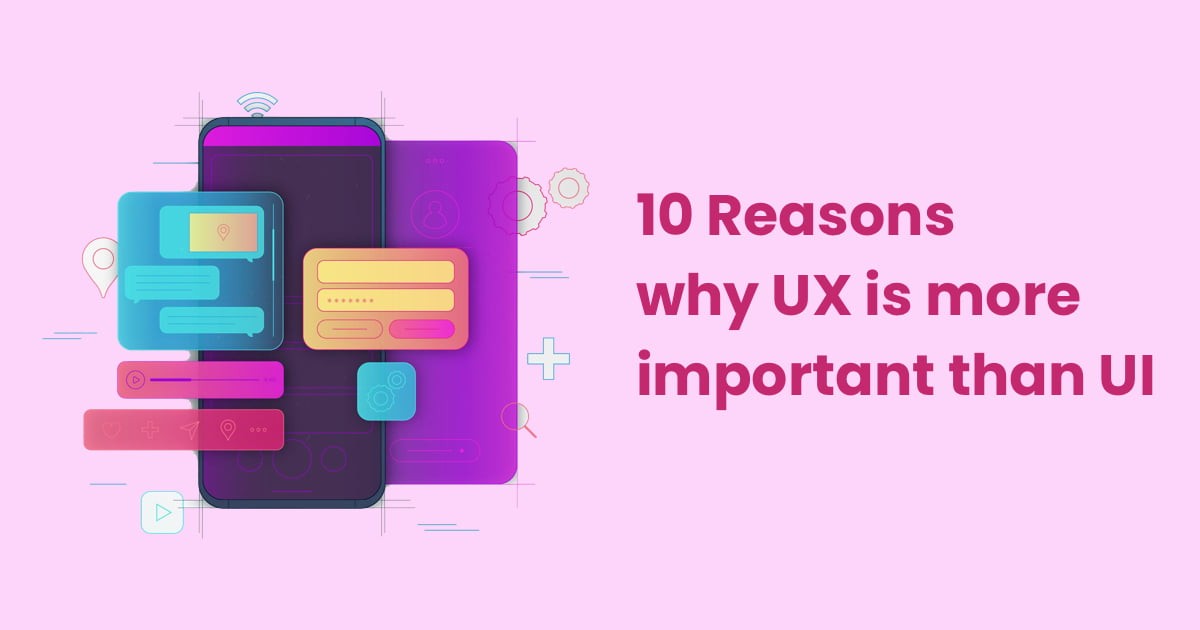
“Design is not just what it looks like and feels like. Design is how it works.”
Steve Jobs
Let us give a thought to this: When we are talking about the design – the way a platform interacts, we do not specifically talk about what we see rather we talk about how the platform is designed for use. This is where UX comes into the picture.
How are UI and UX different?
The difference between User Interface and User Experience is that UI refers to the style components by which users communicate with a product, while UX is about the experience a user has with a product. A cool blue-colored button with a shadow is UI, but how conveniently the user can use the button is UX.
Thus, it is not wrong to say, UI centers around visual interface components like typography, colors, menu bars, and that’s just the beginning, while UX centers around the end-user and their interaction with the product.
UI focuses on the look and feel of the product whereas UX refers to the overall friendliness of the product with the user. UI mainly tries to make the product more visually appealing, on the other hand, UX focuses on delighting the user with a product that is efficient and convenient to use.
Consider the following
Good UX
A design example most are familiar with; Airbnb is leading the charge when it comes to creating a booking experience that gets the job done for websites. Airbnb has clearly done its research. The homepage design addresses typical pain points travelers have when trying to find accommodation.
The homepage also inspires travelers who are unsure where to go by offering popular destinations nearby. It gives a mix of what people love: entire homes, pet-friendly homes, or unique stays. The action of booking is simple and at the top of the fold. Quick, clear, and user-friendly.
Bad UX
WhatsApp rose to fame as the number 1 chat application because of its incredible experience and perfect interface-making it even more astonishing.
WhatsApp is famous for its encrypted messages and security concerns. But probably its designers are too honest to get you off the hook of an accidentally sent or a regretted message. On WhatsApp, when you try to delete your message for everyone, it only hides the content and presents both sides with a note “This message was deleted.”.
But here the backdrop is that it sends a notification to the recipient that the message has been deleted. Informing the other person that the sender has erased a message invalidates the point of erasing it in any case. Honestly, this looks far more suspicious and is probably going to provoke the reader “for what reason did you delete the message?”
Reasons Why UX is Important
- It attempts to satisfy the user’s requirements and assembles a superior user satisfaction-conversion-retention journey.
- UX plans to give positive encounters to the user that keeps them faithful to the product or brand.
- UX characterizes user ventures on your product and builds up a two-way connection between the producer and the user.
- It decreases costs for improvement/bug-fixing/advertising. During the conception of the product UX research helps understand what obstacles are to be avoided. And avoiding a fault is indeed cheaper than correcting it.
- UX gives further developed profit from venture (ROI). UX not only increases conversion rates rather it helps get improved Return on Investment.
- Now and then the product shouldn’t be inventive. It just takes the typical thought and addresses it in an unexpected way. The user-centered plan makes the product outshine others and cut the competition.
- Gives instinctive experience, intelligibility, coherence, and stage explicit plans.
- UX helps in rocketing the SEO rankings of your products and services. User experience is directly proportional to the Search Engine Optimization SEO.
- It’s the most effective idea to make your business and your product outshine all the competitors. To be well-liked by the users, you just need to have a satisfying UX .
- It helps you discover new opportunities for businesses. Listening to users helps in getting valuable insights that can be turned into opportunities.
Conclusion
Finally, the lesson we get is that you ought to keep in mind the advantages of UX for your business. Putting resources into UX is a financial success, as the long-term merits incorporate better ROI as well as lowered costs, and better user retention. However, if you keep your UX up to the mark, you’ll always beat your competition and enjoy incredible user loyalty.









